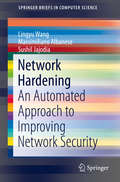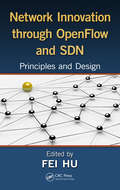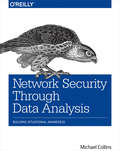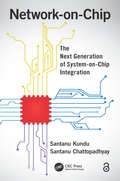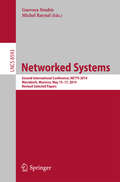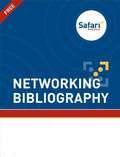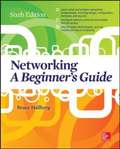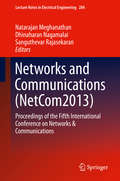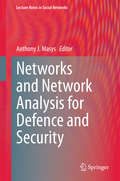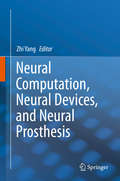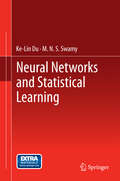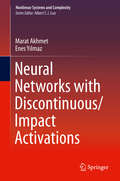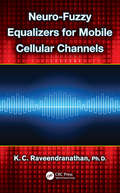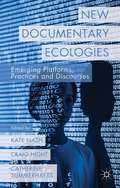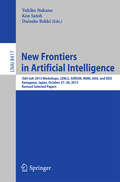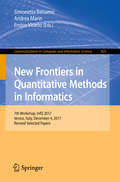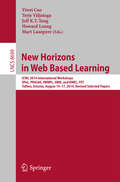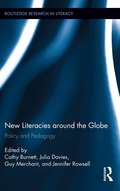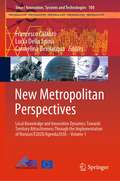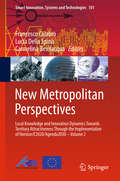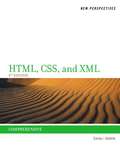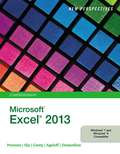- Table View
- List View
Network Hardening
by Sushil Jajodia Lingyu Wang Massimiliano AlbaneseThis Springer Brief examines the tools based on attack graphs that help reveal network hardening threats. Existing tools detail all possible attack paths leading to critical network resources. Though no current tool provides a direct solution to remove the threats, they are a more efficient means of network defense than relying solely on the experience and skills of a human analyst. Key background information on attack graphs and network hardening helps readers understand the complexities of these tools and techniques. A common network hardening technique generates hardening solutions comprised of initially satisfied conditions, thereby making the solution more enforceable. Following a discussion of the complexity issues in this technique, the authors provide an improved technique that considers the dependencies between hardening options and employs a near-optimal approximation algorithm to scale linearly with the size of the inputs. Also included are automated solutions for hardening a network against sophisticated multi-step intrusions. Network Hardening: An Automated Approach to Improving Network Security is a valuable resource for researchers and professionals working in network security. It is also a useful tool for advanced-level students focused on security in computer science and electrical engineering.
Network Innovation through OpenFlow and SDN: Principles and Design
by Fei HuThis book explains how to use software-defined networking (SDN) technologies powered by the OpenFlow protocol to build networks that are easy to design, less expensive to build and operate, and more agile and customizable. Among the first books to systematically address the design aspects in SDN/OpenFlow, it presents the insights of expert contributors from around the world. Focused on OpenFlow engineering design and basic principles, it includes coverage of system architectures, language and programming issues, switches, multimedia support, and network operating systems.
Network Security Through Data Analysis
by Michael S CollinsTraditional intrusion detection and logfile analysis are no longer enough to protect today's complex networks. In this practical guide, security researcher Michael Collins shows you several techniques and tools for collecting and analyzing network traffic datasets. You'll understand how your network is used, and what actions are necessary to protect and improve it.Divided into three sections, this book examines the process of collecting and organizing data, various tools for analysis, and several different analytic scenarios and techniques. It's ideal for network administrators and operational security analysts familiar with scripting.Explore network, host, and service sensors for capturing security dataStore data traffic with relational databases, graph databases, Redis, and HadoopUse SiLK, the R language, and other tools for analysis and visualizationDetect unusual phenomena through Exploratory Data Analysis (EDA)Identify significant structures in networks with graph analysisDetermine the traffic that's crossing service ports in a networkExamine traffic volume and behavior to spot DDoS and database raidsGet a step-by-step process for network mapping and inventory
Network Security Through Data Analysis: From Data to Action
by Michael CollinsTraditional intrusion detection and logfile analysis are no longer enough to protect today’s complex networks. In the updated second edition of this practical guide, security researcher Michael Collins shows InfoSec personnel the latest techniques and tools for collecting and analyzing network traffic datasets. You’ll understand how your network is used, and what actions are necessary to harden and defend the systems within it.In three sections, this book examines the process of collecting and organizing data, various tools for analysis, and several different analytic scenarios and techniques. New chapters focus on active monitoring and traffic manipulation, insider threat detection, data mining, regression and machine learning, and other topics.You’ll learn how to:Use sensors to collect network, service, host, and active domain dataWork with the SiLK toolset, Python, and other tools and techniques for manipulating data you collectDetect unusual phenomena through exploratory data analysis (EDA), using visualization and mathematical techniquesAnalyze text data, traffic behavior, and communications mistakesIdentify significant structures in your network with graph analysisExamine insider threat data and acquire threat intelligenceMap your network and identify significant hosts within itWork with operations to develop defenses and analysis techniques
Network-on-Chip: The Next Generation of System-on-Chip Integration
by Santanu Kundu Santanu ChattopadhyayAddresses the Challenges Associated with System-on-Chip Integration Network-on-Chip: The Next Generation of System-on-Chip Integration examines the current issues restricting chip-on-chip communication efficiency, and explores Network-on-chip (NoC), a promising alternative that equips designers with the capability to produce a scalable, reusable, and high-performance communication backbone by allowing for the integration of a large number of cores on a single system-on-chip (SoC). This book provides a basic overview of topics associated with NoC-based design: communication infrastructure design, communication methodology, evaluation framework, and mapping of applications onto NoC. It details the design and evaluation of different proposed NoC structures, low-power techniques, signal integrity and reliability issues, application mapping, testing, and future trends. Utilizing examples of chips that have been implemented in industry and academia, this text presents the full architectural design of components verified through implementation in industrial CAD tools. It describes NoC research and developments, incorporates theoretical proofs strengthening the analysis procedures, and includes algorithms used in NoC design and synthesis. In addition, it considers other upcoming NoC issues, such as low-power NoC design, signal integrity issues, NoC testing, reconfiguration, synthesis, and 3-D NoC design. This text comprises 12 chapters and covers: The evolution of NoC from SoC—its research and developmental challenges NoC protocols, elaborating flow control, available network topologies, routing mechanisms, fault tolerance, quality-of-service support, and the design of network interfaces The router design strategies followed in NoCs The evaluation mechanism of NoC architectures The application mapping strategies followed in NoCs Low-power design techniques specifically followed in NoCs The signal integrity and reliability issues of NoC The details of NoC testing strategies reported so far The problem of synthesizing application-specific NoCs Reconfigurable NoC design issues Direction of future research and development in the field of NoC Network-on-Chip: The Next Generation of System-on-Chip Integration covers the basic topics, technology, and future trends relevant to NoC-based design, and can be used by engineers, students, and researchers and other industry professionals interested in computer architecture, embedded systems, and parallel/distributed systems.
Networked Systems
by Guevara Noubir Michel RaynalThis book constitutes the revised selected papers of the Second International Conference on Networked Systems, NETYS 2014, held in Marrakech, Morocco, in May 2014. The 20 full papers and the 6 short papers presented together with 2 keynotes were carefully reviewed and selected from 80 submissions. They address major topics such as multi-core architectures; concurrent and distributed algorithms; middleware environments; storage clusters; social networks; peer-to-peer networks; sensor networks; wireless and mobile networks; as well as privacy and security measures to protect such networked systems and data from attack and abuse.
Networking Bibliography
by Safari Content TeamToday it is difficult to avoid networking, from phones to computers and even modern home appliances. Using this bibliography, you will learn to understand how networking works at the low level, how different networks can be connected together and how the Internet works to route data around the world. You will also gain an understanding of the higher level networking principles such as protocol designs and networking application fundamentals.This bibliography is aimed at people with basic network experience. It will guide you through a deeper understanding of how the basics of networking operate, from the physical level, to low-level protocols, network routing and high-level protocol and networking systems. If you are a developer or a network administrator, this will help you acquire a deeper understanding of networking environments.
Networking: A Beginner's Guide 6th Edition
by Bruce HallbergThoroughly revised to cover the latest technologies, this practical resource provides you with a solid foundation in networking fundamentals. Networking: A Beginner's Guide, Sixth Edition discusses wired and wireless network design, configuration, hardware, protocols, security, backup, recovery, and virtualization. You'll also get step-by-step instructions for installing, configuring, and managing Windows Server 2012, Exchange Server 2013, Oracle Linux, and Apache. This is the perfect book for anyone starting a networking career or in need of an easy-to-follow refresher.
Networks and Communications (NetCom2013)
by Natarajan Meghanathan Dhinaharan Nagamalai Sanguthevar RajasekaranThis book covers theory, methodology and applications of computer networks, network protocols and wireless networks, data communication technologies, and network security. The book is based on the proceedings from the Fifth International Conference on Networks & Communications (NetCom). The proceedings will feature peer-reviewed papers that illustrate research results, projects, surveys and industrial experiences that describe significant advances in the diverse areas of computer networks & communications.
Networks and Network Analysis for Defence and Security
by Anthony J. MasysNetworks and Network Analysis for Defence and Security discusses relevant theoretical frameworks and applications of network analysis in support of the defence and security domains. This book details real world applications of network analysis to support defence and security. Shocks to regional, national and global systems stemming from natural hazards, acts of armed violence, terrorism and serious and organized crime have significant defence and security implications. Today, nations face an uncertain and complex security landscape in which threats impact/target the physical, social, economic and cyber domains. Threats to national security, such as that against critical infrastructures not only stem from man-made acts but also from natural hazards. Katrina (2005), Fukushima (2011) and Hurricane Sandy (2012) are examples highlighting the vulnerability of critical infrastructures to natural hazards and the crippling effect they have on the social and economic well-being of a community and a nation. With this dynamic and complex threat landscape, network analysis has emerged as a key enabler in supporting defence and security. With the advent of 'big data' and increasing processing power, network analysis can reveal insights with regards to structural and dynamic properties thereby facilitating greater understanding of complex networks, their entities, interdependencies, vulnerabilities to produce insights for creative solutions. This book will be well positioned to inform defence, security and intelligence professionals and researchers with regards to leading methodologies and approaches.
Neural Computation, Neural Devices, and Neural Prosthesis
by Zhi YangIn the past decades, interdisciplinary investigations overlapping biology, medicine, information science, and engineering have formed a very exciting and active field that attracts scientists, medical doctors, and engineers with knowledge in different domains. A few examples of such investigations include neural prosthetic implants that aim to improve the quality of life for patients suffering from neurologic disease and injury; brain machine interfaces that sense, analyze, and translate electrical signals from the brain to build closed-loop, biofeedback systems; and fundamental studies of intelligence, cognitive functions, and psychological behaviors correlated to their neurological basis. Although this interdisciplinary area is still in its infancy, it can potentially create some of the most significant impact: treating diseases that are considered untreatable, interpretation and communication of neuron ensembles, or even a revolutionary perception and understanding of life different from philosophical or immaterial approaches. Fortunately, several academic societies recognize the value and impact of this growing field, firmly supporting related research. Such support will drive a booming future in the next twenty or thirty years. Research in this area is frequently project-driven, and the generated knowledge has been scattered in different fields of neuroscience, computation, material and technology, circuits and system, clinical reports, and psychology--the scope considerably across the boundary of traditionally defined disciplines. Neural Computation, Neural Devices, and Neural Prosthesis is intended to assemble such knowledge, from there suggesting a systematic approach guiding future educational and research activities. The targeted audience includes both students and researchers.
Neural Networks and Statistical Learning
by Ke-Lin Du M. N. S. SwamyProviding a broad but in-depth introduction to neural network and machine learning in a statistical framework, this book provides a single, comprehensive resource for study and further research. All the major popular neural network models and statistical learning approaches are covered with examples and exercises in every chapter to develop a practical working understanding of the content. Each of the twenty-five chapters includes state-of-the-art descriptions and important research results on the respective topics. The broad coverage includes the multilayer perceptron, the Hopfield network, associative memory models, clustering models and algorithms, the radial basis function network, recurrent neural networks, principal component analysis, nonnegative matrix factorization, independent component analysis, discriminant analysis, support vector machines, kernel methods, reinforcement learning, probabilistic and Bayesian networks, data fusion and ensemble learning, fuzzy sets and logic, neurofuzzy models, hardware implementations, and some machine learning topics. Applications to biometric/bioinformatics and data mining are also included. Focusing on the prominent accomplishments and their practical aspects, academic and technical staff, graduate students and researchers will find that this provides a solid foundation and encompassing reference for the fields of neural networks, pattern recognition, signal processing, machine learning, computational intelligence, and data mining.
Neural Networks with Discontinuous/Impact Activations
by Marat Akhmet Enes YılmazThis book presents as its main subject new models in mathematical neuroscience. A wide range of neural networks models with discontinuities are discussed, including impulsive differential equations, differential equations with piecewise constant arguments, and models of mixed type. These models involve discontinuities, which are natural because huge velocities and short distances are usually observed in devices modeling the networks. A discussion of the models, appropriate for the proposed applications, is also provided.
Neuro-Fuzzy Equalizers for Mobile Cellular Channels
by K.C. RaveendranathanEqualizers are present in all forms of communication systems. Neuro-Fuzzy Equalizers for Mobile Cellular Channels details the modeling of a mobile broadband communication channel and designing of a neuro-fuzzy adaptive equalizer for it. This book focuses on the concept of the simulation of wireless channel equalizers using the adaptive-network-based fuzzy inference system (ANFIS). The book highlights a study of currently existing equalizers for wireless channels. It discusses several techniques for channel equalization, including the type-2 fuzzy adaptive filter (type-2 FAF), compensatory neuro-fuzzy filter (CNFF), and radial basis function (RBF) neural network. Neuro-Fuzzy Equalizers for Mobile Cellular Channels starts with a brief introduction to channel equalizers, and the nature of mobile cellular channels with regard to the frequency reuse and the resulting CCI. It considers the many channel models available for mobile cellular channels, establishes the mobile indoor channel as a Rayleigh fading channel, presents the channel equalization problem, and focuses on various equalizers for mobile cellular channels. The book discusses conventional equalizers like LE and DFE using a simple LMS algorithm and transversal equalizers. It also covers channel equalization with neural networks and fuzzy logic, and classifies various equalizers. This being a fairly new branch of study, the book considers in detail the concept of fuzzy logic controllers in noise cancellation problems and provides the fundamental concepts of neuro-fuzzy. The final chapter offers a recap and explores venues for further research. This book also establishes a common mathematical framework of the equalizers using the RBF model and develops a mathematical model for ultra-wide band (UWB) channels using the channel co-variance matrix (CCM). Introduces the novel concept of the application of adaptive-network-based fuzzy inference system (ANFIS) in the design of wireless channel equalizers Provides model ultra-wide band (UWB) channels using channel co-variance matrix Offers a formulation of a unified radial basis function (RBF) framework for ANFIS-based and fuzzy adaptive filter (FAF) Type II, as well as compensatory neuro-fuzzy equalizers Includes extensive use of MATLAB® as the simulation tool in all the above cases
New Documentary Ecologies
by Kate Nash Craig Hight Catherine SummerhayesProviding a unique collection of perspectives on the persistence of documentary as a vital and dynamic media form within a digital world, New Documentary Ecologies traces this form through new opportunities of creating media, new platforms of distribution and new ways for audiences to engage with the real.
New Frontiers in Artificial Intelligence
by Yukiko Nakano Ken Satoh Daisuke BekkiThis book constitutes the thoroughly refereed post-conference proceedings of the JSAI-isAI 2013 Workshops LENLS, JURISIN, MiMI, AAA, and DDS which tool place on October 2013, in Japan. The 28 contributions in this volume were carefully reviewed and selected from 48 submissions. LENLS (Logic and Engineering of Natural Language Semantics) is an annual international workshop on formal semantics and pragmatics. LENLS10 was the tenth event in the series, and it focused on the formal and theoretical aspects of natural language. JURISIN (Juris-Informatics) 2013 was the seventh event in the series. The purpose of this workshop was to discuss fundamental and practical issues for jurisinformatics, bringing together experts from a variety of relevant backgrounds, including law, social science, information and intelligent technology, logic,and philosophy (including the area of AI and law). MiMI (Multimodality in Multiparty Interaction) 2013 covers topics as follows interaction studies, communication studies, conversation analysis, and workplace studies, as well as their applications in other research fields. AAA (Argument for Agreement and Assurance) 2013 focused on the theoretical foundations of argumentation in AI, and the application of argumentation to various fields such as agreement formation and assurance. DDS (Data Discretization and Segmentation for Knowledge Discovery) 2013 discussed segmentation methods for various types of data, such as graphs, trees, strings, and continuous data, and their applications in the areas of Machine Learning and Knowledge Discovery.
New Frontiers in Artificial Intelligence: JSAI-isAI 2013 Workshops, LENLS, JURISIN, MiMI, AAA, and DDS, Kanagawa, Japan, October 27-28, 2013, Revised Selected Papers (Lecture Notes in Computer Science #8417)
by Yukiko Nakano Ken Satoh Daisuke BekkiThis book constitutes the thoroughly refereed post-conference proceedings of the JSAI-isAI 2013 Workshops LENLS, JURISIN, MiMI, AAA, and DDS which tool place on October 2013, in Japan. The 28 contributions in this volume were carefully reviewed and selected from 48 submissions. LENLS (Logic and Engineering of Natural Language Semantics) is an annual international workshop on formal semantics and pragmatics. LENLS10 was the tenth event in the series, and it focused on the formal and theoretical aspects of natural language. JURISIN (Juris-Informatics) 2013 was the seventh event in the series. The purpose of this workshop was to discuss fundamental and practical issues for jurisinformatics, bringing together experts from a variety of relevant backgrounds, including law, social science, information and intelligent technology, logic,and philosophy (including the area of AI and law). MiMI (Multimodality in Multiparty Interaction) 2013 covers topics as follows interaction studies, communication studies, conversation analysis, and workplace studies, as well as their applications in other research fields. AAA (Argument for Agreement and Assurance) 2013 focused on the theoretical foundations of argumentation in AI, and the application of argumentation to various fields such as agreement formation and assurance. DDS (Data Discretization and Segmentation for Knowledge Discovery) 2013 discussed segmentation methods for various types of data, such as graphs, trees, strings, and continuous data, and their applications in the areas of Machine Learning and Knowledge Discovery.
New Frontiers in Quantitative Methods in Informatics: 7th Workshop, Infq 2017, Venice, Italy, December 4, 2017, Revised Selected Papers (Communications In Computer And Information Science #825)
by Simonetta Balsamo Andrea Marin Enrico VicarioThis book constitutes the refereed proceedings of the 7th Workshop on New Frontiers in Quantitative Methods in Informatics, InfQ 2017, held in Venice, Italy, in December 2017.The 11 revised full papers and the one revised short paper presented were carefully reviewed and selected from 22 submissions. The papers are organized in topical sections on networking and mobile applications; applications of quantitative modeling; big data processing and IoT; theory, methods and tools for quantitative analysis.
New Frontiers in Technological Literacy
by John DakersThis book attempts to rethink the concept of technological literacy in a modern context, not only in terms of a subject area taught in schools, but also as an important general concept that all citizens should engage with. As this book will illustrate, the concept of technological literacy has no universally agreed definition.
New Horizons in Web Based Learning
by Mart Laanpere Yiwei Cao Terje Väljataga Jeff K.T. Tang Howard LeungThis book constitutes the revised selected papers of the workshops of the 13th International Conference of Web-based Learning, ICWL 2014, held in Tallinn, Estonia, in August 2014. This volume comprises papers of six workshops: 1. The Seventh International Workshop on Social and Personal Computing for Web-Supported Learning Communities (SPeL 2014) 2. The First International Workshop on Peer-Review, Peer-Assessment, and Self-Assessment in Education (PRASAE 2014) 3. International Workshop on Mobile and Personalized Learning (IWMPL 2014) 4. The First International Workshop on Open Badges in Education (OBIE 2014) 5. The Fourth International Symposium on Knowledge Management & E-Learning (KMEL 2014) 6. The Future of e-Textbooks Workshop (FeT 2014).
New Literacies around the Globe: Policy and Pedagogy (Routledge Research in Literacy)
by Jennifer Rowsell Cathy Burnett Guy Merchant Julia DaviesThe increasing popularity of digitally-mediated communication is prompting us to radically rethink literacy and its role in education; at the same time, national policies have promulgated a view of literacy focused on the skills and classroom routines associated with print, bolstered by regimes of accountability and assessments. As a result, teachers are caught between two competing discourses: one upholding a traditional conception of literacy re-iterated by politicians and policy-makers, and the other encouraging a more radical take on 21st century literacies driven by leading edge thinkers and researchers. There is a pressing need for a book which engages researchers in international dialogue around new literacies, their implications for policy and practice, and how they might articulate across national boundaries. Drawing on cutting edge research from the USA, Canada, UK, Australia and South Africa, this book is a pedagogical and policy-driven call for change. It explores studies of literacy practices in varied contexts through a refreshingly dialogic style, interspersed with commentaries which comment on the significance of the work described for education. The book concludes on the ‘conversation’ developed to identify key recommendations for policy-makers through a Charter for Literacy Education. .
New Metropolitan Perspectives: The Integrated Approach Of Urban Sustainable Development (Advanced Engineering Forum Vol. 11 Ser. #100)
by Francesco Calabrò Lucia Della Spina Carmelina BevilacquaThis book explores the role of cities and the urban–rural linkages in spurring innovation embedded in spatial planning, strategic and economic planning, and decision support systems. In particular, the contributions examine the complexity of the current transitional phase towards achieving smart, inclusive and sustainable growth, and investigate the post-2020 UE cohesion policy.The main topics include: Innovation dynamics and smart cities; Urban regeneration – community-led and PPP; Inland and urban area development; Mobility, accessibility, infrastructures; Heritage, landscape and Identity; and Risk management, Environment and Energy.The book includes a selection of articles accepted for presentation and discussion at the 3rd International Symposium New Metropolitan Perspectives (ISTH2020), held at the University of Reggio Calabria, Italy on 22–25 May 2018. The symposium, which addressed the challenge of local knowledge and innovation dynamics towards territory attractiveness, hosted the final event of the MAPS-LED project under Horizon2020 – MSCA RISE.
New Metropolitan Perspectives: The Integrated Approach Of Urban Sustainable Development (Advanced Engineering Forum Vol. 11 Ser. #101)
by Francesco Calabrò Lucia Della Spina Carmelina BevilacquaThis book explores the role of cities and the urban–rural linkages in spurring innovation embedded in spatial planning, strategic and economic planning, and decision support systems. In particular, the contributions examine the complexity of the current transitional phase towards achieving smart, inclusive and sustainable growth, and investigate the post-2020 UE cohesion policy.The main topics include: Innovation dynamics and smart cities; Urban regeneration – community-led and PPP; Inland and urban area development; Mobility, accessibility, infrastructures; Heritage, landscape and Identity; and Risk management, Environment and Energy.The book includes a selection of articles accepted for presentation and discussion at the 3rd International Symposium New Metropolitan Perspectives (ISTH2020), held at the University of Reggio Calabria, Italy on 22–25 May 2018. The symposium, which addressed the challenge of local knowledge and innovation dynamics towards territory attractiveness, hosted the final event of the MAPS-LED project under Horizon2020 – MSCA RISE.
New Perspectives On HTML, CSS, and XML: Comprehensive
by Patrick CareyNEW PERSPECTIVES ON HTML, CSS, AND XML, COMPREHENSIVE, 4E teaches students how to create simple to complex Web sites from scratch using HTML, CSS, AND XML. Students are asked to think critically in order to solve problems and complete Case Studies, which reinforces key concepts critical to creating Web pages.
New Perspectives on Microsoft Excel 2013: Comprehensive
by Dan Oja Patrick Carey June Jamrich Parsons Roy Ageloff Carol A. DesjardinsUpdated with all new case-based tutorials, New Perspectives Microsoft Excel 2013 continues to engage students in applying skills to real-world situations, making concepts relevant.
